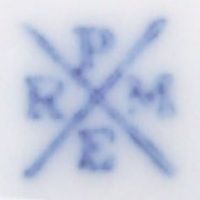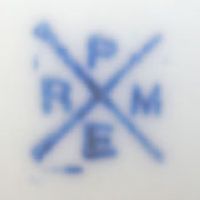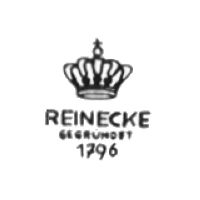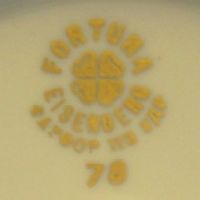
Image 011203-02-01
Used between 1850 and 1865.
This factory was founded in 1796 by Heinrich Ernst Mühlberg who already owned minor porcelain facilities in Volkstedt and Gera and had opened a decoration studio in Roschütz in 1789. For the first few years everything went well and in 1806 Mühlberg took in two partners (the Döll brothers from Altenberg) who used parts of his Eisenberg factory to produce stoneware. This however lead to some complications and in 1819 he cancelled the agreement again as the former quite good running porcelain business was now officially only listed as 'minor manufacturer'.
Mühlberg started to restructure his business and managed to turn away bankruptcy before he finally died in 1826, leaving the business to his wife who continued his work and was responsible for the good reputation the factory had around 1830. The company therefore saw another good period until Mrs. Mühlberg died in 1845, but their son Karl Mühlberg who then took over business never had been very interested in the work of his parents and managed to ruin everything, forcing him to file for bankruptcy in 1847. Until then Karl Mühlberg had managed to keep up the reputation as successful businessman but as he had actually cheated many people into investing money he was forced to evade his creditors and vanish.
The court decided that the factory should fall to the main creditor Hermann Schulz who had always invested a little even when Heinrich Ernst Mühlberg was still alive. He instantly continued business but needed some time before he could actually get through the muddle Karl Mühlberg had left behind and so it took until 1856 before the factory had paid off all other creditors. After Schulz had achieved this main goal the company for the first time in years showed a positive balance but as a businessman he knew that he needed a further investment to pay for some badly needed modernizations.
After pondering on the idea of looking for an investor Schulz closed the factory the same year for a few months simply to save money and then finally took up a loan which allowed him to continue. His plan worked out and by the year 1864 the totally recovered business with a mere 45 employees even exported items to Denmark, France and Sweden and had a solid reputation. But Schulz was by now growing old and wanted to retire and after that became known he was literally covered with offers as the factory had become a very interesting object for other businessmen.
The result was that in 1865 the businessman Friedrich August Reinecke from Roschütz took over the factory and again partially modernized it, thus further increasing its output. When Reinecke himself retired in 1910 he left the factory to his sons Paul and Otto Reinecke who together concentrated their work on the German market but also started to export a large number of cups and mugs to both England and the US. Only three years later export had become an important part of the business and the introduction of items decorated in a very popular 'Blue Onion' substyle helped the brothers to expand further.
Over these years the younger brother Paul had proven more than once that he was a great businessman and totally capable of running the business alone, so in 1937 Otto Reinecke decided to leave as he for some time had been shareholder and director of the Porzellanfabrik Moschendorf AG in Bavaria, a business he now planned to take over completely. Paul Reinecke led his factory very well over the following years and after the founding of the German Democratic Republic in 1949 he continued business under state supervision. One of his last actions before he retired was to arrange the merger with the Porzellanfabrik Wilhelm Jäger also located in Eisenberg; this in 1960 resulted in the company of Vereinigte Kunstporzellanwerke Eisenberg.
The company remained a private venture under state supervision but the growing influence of the state in private business affairs slowly forced all facilities to neglect certain activities like modernization and other reinvestments. The negative side effects of these proceedings in the Eisenberg area increased and by the time the company was fully nationalized in 1973 the factory itself was already showing various signs of fatigue and one kiln had been rendered useless due to missing spare parts and service. All this already indicated what would happen and even if the factory was still part of the merger with other companies under the name of VEB Spezialkombinat Porzellan Eisenberg, the by then totally run down Porzellanfabrik F.A. Reinecke was closed in 1975.

Image 011203-02-01
Used between 1850 and 1865.

Image 011203-02-02
Used between 1850 and 1865.

Image 011203-02-03
Used between 1850 and 1865.

Image 011203-03-01
Used between 1870 and 1926.

Image 011203-03-02
Used between 1870 and 1926.

Image 011203-03-03
Used between 1927 and 1973, registered at the RWZR under №·377·985 on December 9th 1927.

Image 011203-04-01
Used between 1960 and 1973.

Image 011203-04-02
Used between 1960 and 1973, here with cyrillic 'Product of GDR' addition.

Image 011203-04-03
Used between 1960 and 1973, another example in gold.
(Picture: Ivan Golsky)
© 2004-2024 C.S.Marshall, all rights reserved